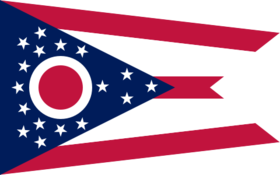Ohio: The Nation’s Battleground Since 1828
Ohio has been the most politically divided state in the country in presidential elections for the last 184 years – boasting the lowest average victory margin and the largest number and percentage of races decided by less than five points

Won by Obama by just 2 points (provisional ballots pending), the state was the second most closely-decided in the nation, behind only Florida at 0.9 points.
With official results yet to be certified in all 50 states, the margin in Ohio (+2.0 Obama) is currently the second closest to the national popular vote (+3.3 Obama) behind only Virginia (+3.7 Obama).
There is no reason to expect Ohio will not be right back in the thick of things in 2016 as well, as it continues to be the most competitive – and politically divided – state in U.S. presidential electoral history.
A Smart Politics review of the 47 presidential election cycles since the birth of the modern two-party system in 1828 finds Ohio leads the nation in both the lowest average victory margin (8.8 points) as well as the largest number (23) and percentage (49 percent) of highly competitive contests decided by less than five points.
While the number and geographic location of competitive states in presidential elections has at times shifted from generation-to-generation and even cycle-to-cycle, the battleground epicenter remains in Ohio.
From the first modern two-party presidential contest in 1828, to the debut of the Republican Party in 1856, through the populist surge of the 1890s, through the Democratic rebirth in the 1930s and 1940s, and through the modern era of divided parties and obscene campaign coffers, Ohio has been a closely-divided and highly-prized state at the top of the ticket.
For starters, Ohio is the only state in the nation to boast an average victory margin in single digits across the last 47 presidential election cycles.
Overall, candidates have averaged an 8.8-point margin of victory in the Buckeye State, which is less than half the national statewide average of 18.8 points (19.8 points if including the District of Columbia).

Delaware is ranked #2 with an average victory margin of 10.1 points over the last 184 years.
Delaware has had only one race decided by more than 25 points (voting for Herbert Hoover in 1928 by 30.4 points) and was one of just three states (along with Massachusetts and New Hampshire) decided by single digits during all four of FDR’s victories from 1932 to 1944.
Next is Indiana at #3 (averaging 10.4 points since 1828), with Maryland at #4 (10.8 points), and New Jersey and New York tied at #5 (11.2 points).
Rounding out the Top 10 are New Mexico at #7 (11.6 points), Illinois at #8 (12.0 points), and West Virginia and Oregon tied at #9 (12.1 points).
All but two of the 10 least competitive states throughout history are located in the South.
Arkansas and Florida are tied at #41 with an average victory margin of 23.6 points, followed by Utah at #43 (26.1 points), Louisiana at #44 (29.8 points), Vermont at #45 (31.5 points), Alabama at #46 (31.7 points), Texas at #47 (32.4 points), Georgia at #48 (32.6 points), Mississippi at #49 (44.4 points), and South Carolina at #50 (46.0 points).
(The District of Columbia has had an average victory margin of 71.9 points during the 13 cycles in which it has cast three electoral votes since 1964).
Ohio is far and away the nation’s leader with nearly half of its presidential contests decided by less than five points (23 of 47, 48.9 percent) and almost three-quarters decided by single digits (33 of 47, 70.2 percent).
Only one other state has compiled victory margins of less than five points at least 40 percent of the time (New Jersey, 20 of 47, 42.6 percent) and only one other has tallied single-digit victory margins in at least 60 percent of presidential elections (Pennsylvania, 29 of 47, 61.7 percent).
Ohio has also recorded four presidential contests decided by less than one point:
· 1892: Voting for incumbent Republican Benjamin Harrison over Grover Cleveland by 0.13 points.
· 1944: Supporting Republican Thomas Dewey over incumbent Franklin Roosevelt by 0.37 points.
· 1948: Backing incumbent Democrat Harry Truman over Thomas Dewey by 0.24 points.
· 1976: Voting for Democrat Jimmy Carter over incumbent Gerald Ford by 0.27 points.
That ranks tied for fourth in the nation for the most razor-thin contests over the last 184 years.
California leads with a remarkable nine presidential contests decided by less than a point, or 22 percent of the 41 elections in which it has participated since statehood, but none in the last 50 years: 1860, 1868, 1880, 1892, 1896, 1912, 1916, 1948, 1960.
Maryland has tallied six such elections (1828, 1832, 1860, 1872, 1904, 1908) with Missouri at five (1860, 1908, 1956, 1960, 2008) and Kentucky (1896, 1920, 1952, 1996) and Tennessee (1844, 1952, 1956, 1980) also tied with Ohio at four.

During the nine cycles from 1828 through 1860, the battle for Ohio was decided by single digits every time, including six of these by less than five points: in 1828 (3.2 points), 1832 (3.0 points), 1836 (4.3 points), 1840 (8.5 points), 1844 (1.9 points), 1848 (5.0 points), 1852 (4.7 points), 1856 (4.3 points), and 1860 (7.9 points).
The Buckeye State voted Democratic four times (1828, 1832, 1848, 1852), Whig three times (1836, 1840, 1844), and Republican twice (1856, 1860) during this period.
After support Abraham Lincoln by 12.7 points over George McClellan during his reelection bid in 1864, Ohio was again decided by single digits again for nine more consecutive cycles, including another six by less than five points.
Ohio voted Republican each time: in 1868 (by 8.0 points), 1872 (7.1 points), 1876 (1.1 points), 1880 (4.7 points), 1884 (4.1 points), 1888 (2.3 points), 1892 (0.1 points), 1896 (4.9 points), and 1900 (6.6 points).
Although there was only one competitive presidential race nationally from 1904 to 1936 (Woodrow Wilson’s reelection victory in 1916), Ohio still managed to eke out three moderately competitive races statewide with William Taft winning the state by 6.2 points in 1908, Wilson carrying it by 7.7 points in 1916, and FDR winning it by just 2.9 points in 1932.
Ohio had the two closest contests in the nation in 1944 (backing Dewey by 0.4 points) and 1948 (backing Truman by 0.2 points).
Over the 14 election cycles since 1960, the average victory margin in Ohio of 8.4 points is third lowest in the nation behind Wisconsin (6.9 points) and Pennsylvania (8.3 points).
In recent years, Ohio is one of just five states since 1992 to have all six presidential contests decided by single digits (along with Colorado, Florida, New Hampshire, and Virginia).
With an average victory margin in the state of just 3.4 points, Ohio is second to Florida (2.7 points) for the narrowest margins during this 20-year span.
Narrowest Average Margin of Victory in Presidential Elections, 1828-2012
|
Rank
|
State
|
< 5
|
5 < 10
|
Cycles
|
% < 5
|
% < 10
|
MoV
|
|
1
|
Ohio
|
23
|
10
|
47
|
48.9
|
70.2
|
8.8
|
|
2
|
Delaware
|
15
|
10
|
46
|
32.6
|
54.3
|
10.1
|
|
3
|
Indiana
|
15
|
8
|
47
|
31.9
|
48.9
|
10.4
|
|
4
|
Maryland
|
15
|
12
|
47
|
31.9
|
57.4
|
10.8
|
|
5
|
New Jersey
|
20
|
6
|
47
|
42.6
|
55.3
|
11.2
|
|
5
|
New York
|
17
|
10
|
47
|
36.2
|
57.4
|
11.2
|
|
7
|
New Mexico
|
6
|
6
|
26
|
23.1
|
46.2
|
11.6
|
|
8
|
Illinois
|
16
|
7
|
47
|
34.0
|
48.9
|
12.0
|
|
9
|
West Virginia
|
8
|
9
|
38
|
21.1
|
44.7
|
12.1
|
|
9
|
Oregon
|
13
|
8
|
39
|
33.3
|
53.8
|
12.1
|
|
11
|
Pennsylvania
|
17
|
12
|
47
|
36.2
|
61.7
|
12.3
|
|
11
|
Wisconsin
|
15
|
8
|
42
|
35.7
|
54.8
|
12.3
|
|
13
|
California
|
14
|
3
|
41
|
34.1
|
41.5
|
12.5
|
|
14
|
Kentucky
|
11
|
13
|
47
|
23.4
|
51.1
|
12.6
|
|
15
|
Connecticut
|
15
|
11
|
47
|
31.9
|
55.3
|
12.7
|
|
16
|
Missouri
|
15
|
10
|
47
|
31.9
|
53.2
|
12.9
|
|
17
|
Iowa
|
7
|
10
|
42
|
16.7
|
40.5
|
13.9
|
|
18
|
Michigan
|
9
|
13
|
45
|
20.0
|
48.9
|
14.1
|
|
19
|
New Hampshire
|
13
|
11
|
47
|
27.7
|
51.1
|
14.3
|
|
20
|
Washington
|
5
|
7
|
31
|
16.1
|
38.7
|
15.4
|
|
21
|
North Carolina
|
12
|
10
|
46
|
26.1
|
47.8
|
15.5
|
|
22
|
Tennessee
|
14
|
9
|
46
|
30.4
|
50.0
|
15.6
|
|
23
|
Minnesota
|
7
|
8
|
39
|
17.9
|
38.5
|
15.7
|
|
24
|
Montana
|
7
|
6
|
31
|
22.6
|
41.9
|
16.0
|
|
25
|
Colorado
|
5
|
9
|
34
|
14.7
|
41.2
|
16.1
|
|
26
|
South Dakota
|
6
|
4
|
31
|
19.4
|
32.3
|
16.4
|
|
27
|
Virginia
|
10
|
9
|
45
|
22.2
|
42.2
|
16.5
|
|
28
|
Nevada
|
9
|
5
|
38
|
23.7
|
36.8
|
16.8
|
|
29
|
Arizona
|
3
|
5
|
26
|
11.5
|
30.8
|
17.2
|
|
30
|
Maine
|
7
|
5
|
47
|
14.9
|
25.5
|
18.6
|
|
31
|
Oklahoma
|
2
|
5
|
27
|
7.4
|
25.9
|
19.8
|
|
32
|
North Dakota
|
4
|
5
|
31
|
12.9
|
29.0
|
19.9
|
|
33
|
Hawaii
|
3
|
2
|
14
|
21.4
|
35.7
|
20.0
|
|
34
|
Massachusetts
|
6
|
10
|
47
|
12.8
|
34.0
|
20.5
|
|
35
|
Alaska
|
2
|
1
|
14
|
14.3
|
21.4
|
20.6
|
|
35
|
Rhode Island
|
6
|
3
|
47
|
12.8
|
19.1
|
20.6
|
|
37
|
Wyoming
|
5
|
2
|
31
|
16.1
|
22.6
|
20.8
|
|
38
|
Kansas
|
2
|
10
|
38
|
5.3
|
31.6
|
22.0
|
|
39
|
Nebraska
|
3
|
3
|
37
|
8.1
|
16.2
|
22.3
|
|
40
|
Idaho
|
5
|
3
|
31
|
16.1
|
25.8
|
22.8
|
|
41
|
Arkansas
|
2
|
6
|
44
|
4.5
|
18.2
|
23.6
|
|
41
|
Florida
|
7
|
7
|
40
|
17.5
|
35.0
|
23.6
|
|
43
|
Utah
|
2
|
4
|
30
|
6.7
|
20.0
|
26.1
|
|
44
|
Louisiana
|
7
|
6
|
46
|
15.2
|
28.3
|
29.8
|
|
45
|
Vermont
|
2
|
5
|
47
|
4.3
|
14.9
|
31.5
|
|
46
|
Alabama
|
4
|
4
|
46
|
8.7
|
17.4
|
31.7
|
|
47
|
Texas
|
6
|
1
|
40
|
15.0
|
17.5
|
32.4
|
|
48
|
Georgia
|
5
|
5
|
46
|
10.9
|
21.7
|
32.6
|
|
49
|
Mississippi
|
5
|
3
|
45
|
11.1
|
17.8
|
44.4
|
|
50
|
South Carolina
|
4
|
4
|
37
|
10.8
|
21.6
|
46.0
|
|
51
|
DC
|
0
|
0
|
13
|
0.0
|
0.0
|
71.9
|
|
|
Total
|
431
|
343
|
2,001
|
21.5
|
38.7
|
19.8
|
Table compiled by Smart Politics.
Follow Smart Politics on Twitter.
